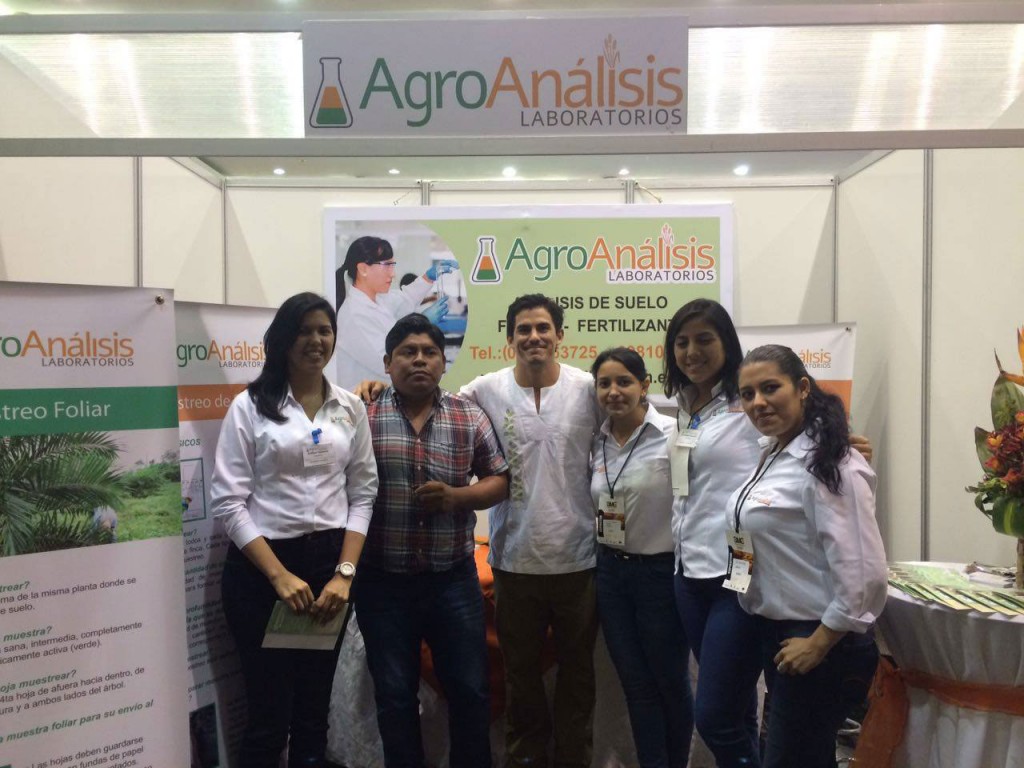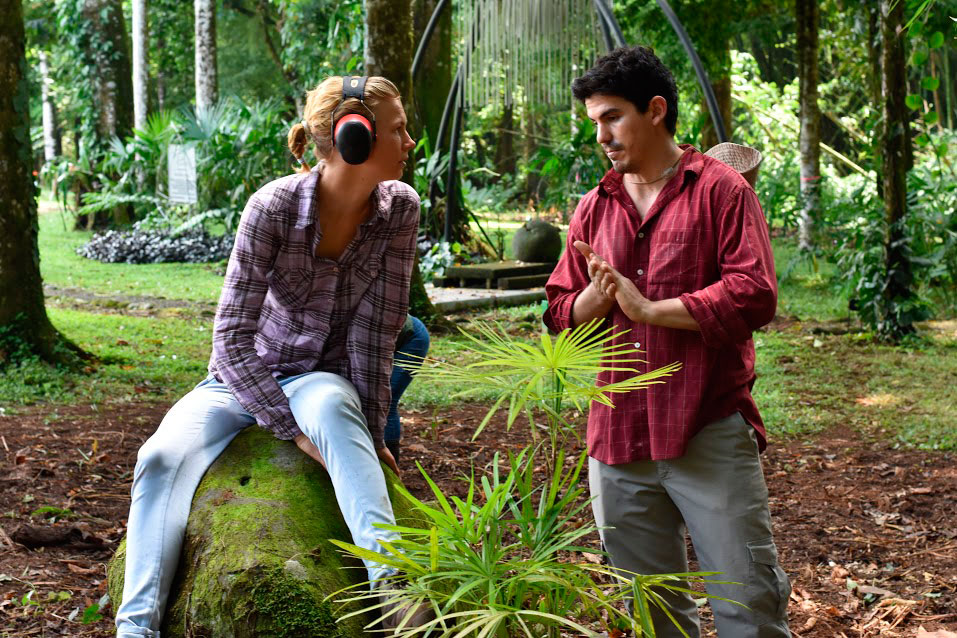The case for unconventional education
In April at the University of Oxford, the Skoll Centre for Social Entrepreneurship recognized EARTH as a “breakthrough educational leader” in a multi-session event highlighting innovative education models that advance social change.
In a panel discussion session, EARTH’s education model was presented, along with facts about the more than 2,100 leaders of change the University has prepared in 27 years.
The panel featured EARTH’s president emeritus José Zaglul and EARTH student José Carlos Rodríguez (’17, Costa Rica). Other panelists included Chris Bradford, founder and CEO of the African Leadership Academy, and Jihad Hajjouji, a Stanford University student. The discussion was moderated by Debra Dunn, cofounder of the FEED Collaborative at Stanford.
“My role at the forum was to tell the experience of a fourth-year EARTH student and present the University’s education model. People were amazed by the student entrepreneurial projects and kept asking how we can be allowed to build businesses that can lose or make money,” José Carlos said. “That only reaffirmed just how fortunate we are to study at EARTH, thanks to the help of our donors. I recognize it would have taken me a lot longer to become a professional if not for the opportunity to attend EARTH.”
The hour-long session can be viewed in its entirety in the video below.
According to the Skoll Foundation, the key to success of both EARTH and the African Leadership Academy lies in three main points.
1. Creating opportunities for young entrepreneurs
2. Placing the emphasis on learning rather than teaching
3. Inspiring educators to reconsider their roles
To learn more about these three points, check out this Skoll blog post.
Why is EARTH’s education model unconventional?
To start, EARTH’s mission is distinct: to form ethical leaders who will contribute to global sustainable development and build just, prosperous societies.
Moreover, EARTH provides a quality education to young entrepreneurs who’ve been selected for their passion for community development and sustainable agriculture, not their ability (or inability) to pay.
“EARTH’s early success is the direct result of several key factors. The first was the vision of the founders who understood that a new model for higher education was necessary to form transformational leaders capable of bringing significant, positive change to eliminate poverty, end hunger, stop violence, and promote peace. EARTH’s founders accepted our strategic, but very risky, proposal of a model that broke from academic tradition,” Zaglul said.
Another differentiator is EARTH’s curriculum.
First-year students focus on work experiences in addition to taking foundational courses such as Tropical Crops and Tropical Animal Production. They also begin planning their entrepreneurial projects. On top of all this, they’re adapting to university life often in a country far from home and, for the non-Spanish speaker, to a new language.
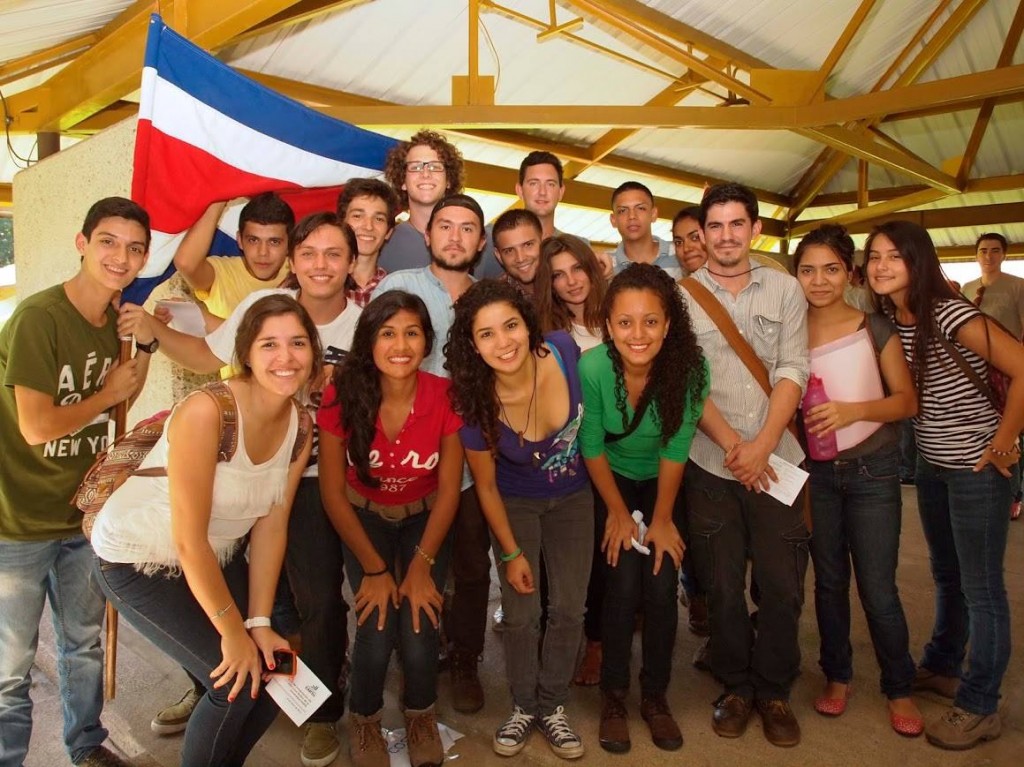
A portion of the Class of 2014-2017 on their first day of classes at EARTH. The mustached student to the right with his arms crossed is José Carlos.
The main component of the second-year experience is becoming social entrepreneurs. Students are responsible for the planning, building and managing of their sustainable agribusiness in the Entrepreneurial Project (EP) course.
Among the preliminary questions reflected on during the planning stage, according to EP Professor Elmer Cantarero, are:
- Why is your project important for the community or the world?
- How does it benefit the environment?
- Does your business have the potential to be financially sustainable, meaning the sale of your products and/or services can finance the operation in perpetuity?
- How do decisions guided by ethical principles make a difference?
Between four and six students form each group. Groups are encouraged to be multicultural, and at least one member of each must be Costa Rican – an effort to equip each business with a native’s understanding of the local market. Furthermore, each teammate has a specific role: general manager, financial manager, sales manager, advertising manager, etc.
José Carlos’s entrepreneurial project, a food manufacturing business called Armonisa, took advantage of in-season fruits from local growers to produce dried fruit and marmalades.
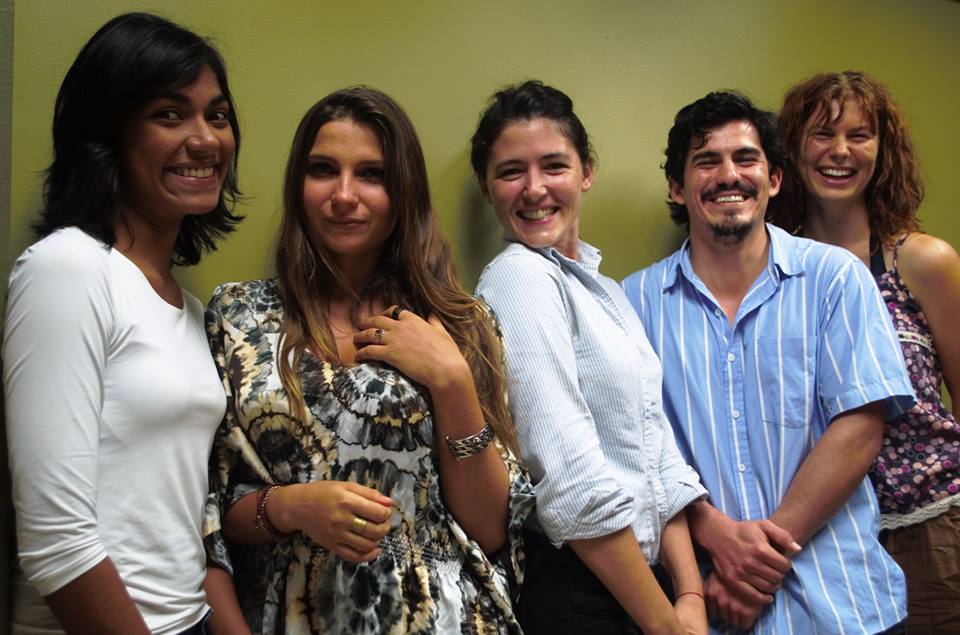
José Carlos Rodríguez (blue shirt) with his Armonisa business partners Fátima (far left), Ambra, Sofía and Jana.
In their third year, EARTH students spend 15 week in a professional internship abroad. Each is in charge of managing their respective internship application process – gathering recommendation letters, writing essays, building resumes, etc.
In 2016, 28 different countries hosted 101 EARTH students, who each put into practice their knowledge of community development, precision agriculture, scientific research, animal production, crops, periurban farming, and climate change agriculture, among others.
“My internship made it clear to me what I want to be when I graduate, and how to carry myself as a professional. I completed a job that left my bosses very pleased and, in turn, gave me a lot of professional confidence. The experience benefited me as a person and as a future agronomist, and it helped me realize that all I had learned in my classes has prepared me to face the real world,” said José Carlos, commenting on his time in Guayaquil, Ecuador, with ALIA2 S.A., a business specializing in precision agriculture, rural development and waste management.
In their fourth and final year at EARTH, students concentrate on developing their thesis-equivalent Graduation Project, which they present for evaluation their penultimate month on campus.
Meanwhile, they spend their time organizing the EARTH Multicultural Fair, an annual activity that raises funds to pay travel expenses to bring parents to graduation. Some students from faraway places or of very scarce resources wouldn’t be able to share the momentous day with their parents otherwise.
All of these factors – a diverse student community numbering more than 400, a network of more than 2,100 graduates of 39 nationalities, a 40-member faculty from 19 countries, and more than 800 support employees across the world, combined with our responsible growing of internationally certified bananas, maintaining organic and periurban agricultural operations, our leading role in proliferating renewable energy within Central America, and our focus on putting theory into practice – make EARTH a different kind of university.
“EARTH offers a holistic education that teaches us to work side-by-side with the producer and, at the same time, learn from them,” José Carlos said in the forum.
“We feed passion and prepare students to leave and effect their own changes,” Zaglul added.
The Example of Hojancha
José Carlos’s family lives in Hojancha, the smallest canton in the Pacific province of Guanacaste. Its population numbers only 7,200 (according to the 2011 Costa Rican census), yet it’s the site of one of the greatest conservation feats in the small Central American nation.
“Some 30 or 40 years ago, the local river dried up due to the area’s deforestation. From the resulting hardship, the community learned its lesson. A foundation was formed and each family contributed. The foundation bought the lands near the former river’s source. Together, we labored, reforesting the area, and, in time, saw the river flow again. The forest was regenerated and remains key to our home’s ecology and biodiversity,” José Carlos said.

The new forest in Hojancha was populated with “pioneer species” – trees that grow to great height so that even more vegetation can crop up and flourish beneath its canopy. Photo: Reserva El Toledo’s Facebook
The river to which he refers is the Nosara, whose upper part is now protected as part of a wildlife reserve under the name Zona Protectora Monte Alto.
The vast majority of Hojancha’s residents now privately own some 74 percent of the canton’s land, as opposed to leasing it. This has allowed the area to set its own future, along with facilitating access to financial tools and lines of credit. Equitable distribution of land1 is considered one of the drivers of the development model.
José Carlos’s family, thanks to an inheritance, obtained a timber property in Hojancha containing 26 hectares (about 64 acres) of trees. After selling the trees, his uncles and father didn’t know what to do with the land.
Once José Carlos was accepted to EARTH, it dawned on them.
“There was always a desire to do something personal, to build a family business, and this started gaining steam when I started studying here [at EARTH]. Our piece of property is now dedicated to conservation,” he added. “Three or four years ago, the fruit crops were established, the infrastructure was developed to facilitate the stay of researchers and people who use the trails to hike the forested and agricultural areas. We also started a small garden where there are medicinal plants and vegetables for cooking.”
The property, today known as Reserva el Toledo, receives eco-minded visitors and researchers from universities and forest schools, among others. The many projects on the property have created stable jobs for three area families as well. Local craftsman and laborers were contracted to complete the entire construction and remodeling process. In fact, the family business enforces a policy: Any and all work needed for the reserve must be provided by local vendors and workers, in an effort to strengthen the cash flow within the community.
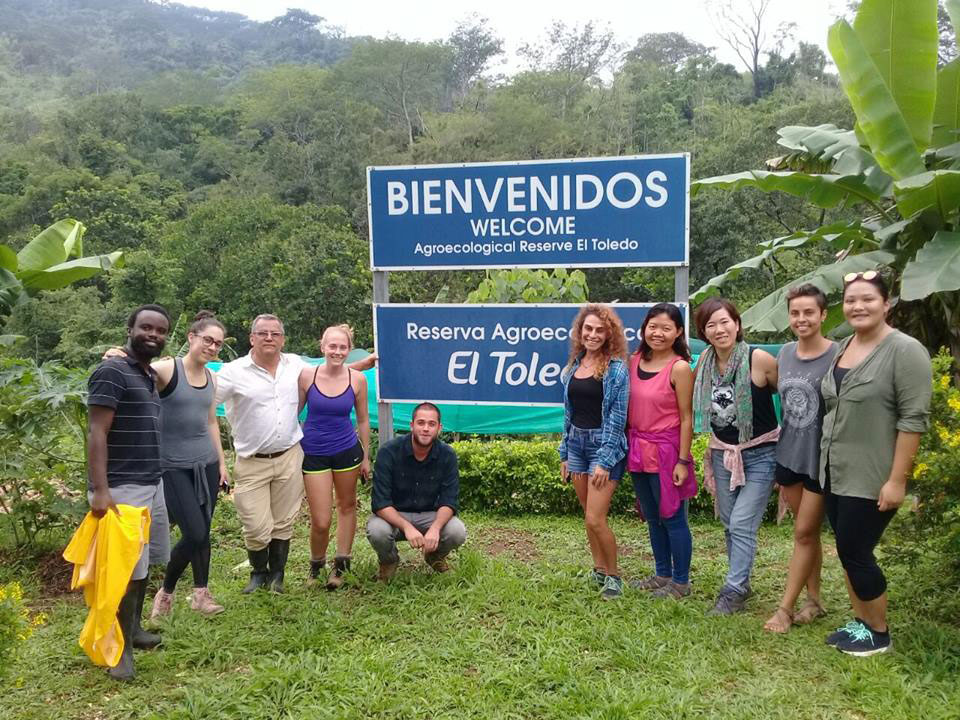
A group from the University for Peace of San José, Costa Rica, tours the reserve on May 20, 2017. Photo: Reserva El Toledo’s Facebook page
According to José Carlos, Hojancha is a model of conservation because the community united from within, drew up a conservation action plan and changed its ways.
Reserva El Toledo hopes to continue integrating the concept of community into its work.
“One of our friends owns a dairy and I would like to assess its potential for biodigestors and improve its production. This way, the good practices we use aren’t only things that we do ourselves, but things we can spread to others as well,” José Carlos said. “As we’ve been taught in the University, if you know how to apply a technology and a neighbor shows openness to the idea, opportunity to put our education to use for others and ensure all goes well. As we are young entrepreneurs as well, reaching out in this way can create jobs and endow a long-term stability.”
Hojancha, now in the hands of a future graduate, and EARTH University are characterized for breaking paradigms and using education as their principal tool. Whether being used to create more just societies or for environmental conservation within communities, unconventional education is demonstrating its power to transform the world.
Learn more about EARTH University and how to support the dreams of hundreds of young social entrepreneurs by clicking here.
References:
https://es.wikipedia.org/wiki/Cant%C3%B3n_de_Hojancha
ftp://ftp.catie.ac.cr/Jordonez/ICRAF%20work0/CATIE/Cuerso%20DF%20CATIE%201014/Publicaciones%20CATIE/Publicaciones_Bosques/Sistematizacion%20Hojancha.pdf
https://www.youtube.com/watch?v=acdj5xXodlg
https://www.youtube.com/watch?v=NEJGahuEiXc

